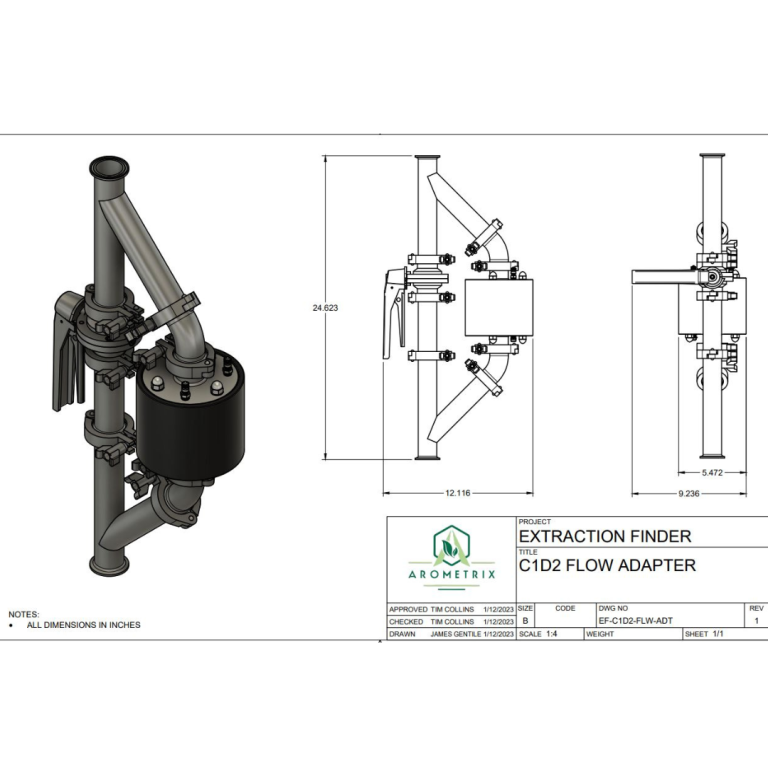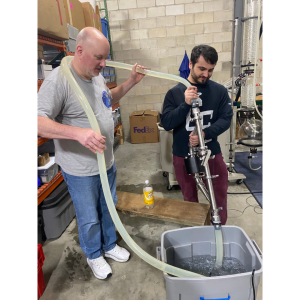Arometrix | Flow Adapter R&D Test a SUCCESS?
Flow Adapter R&D Test a SUCCESS?
What we learned, and how we can extend the ways to use the Extraction Finder

Arometrix’s team of skilled and expert engineers came together today to solve a problem. They developed a flow adapter for the infamous Extraction Finder (EF), a molecular analyzer that uses In-situ fluorescence spectrometry to determine the ratio of fluorescing molecules found in Cannabis Hydrocarbon Extraction ranging from CBD to Chlorophyll and even lipids and more.
The Extraction Finder, while great for Hydrocarbon extraction, needed some attention in order to be compatible with larger flow processes like ethanol and solventless extraction processing. It was Hypothesized that the flow rate needed for a solventless process may not be fulfilled by the current extraction finder’s much smaller internal diameter (½”).
The EF is great as it is; we just need to engineer an adapter that wouldn’t interrupt the efficiency of the process but still be able to pass a sample of the extraction fluid by the EF so processors can still have in-situ monitoring of their process. Further, the extraction finder had recently undergone significant optical upgrades to improve its sensitivity, which also improved its ruggedness and buildability too. We wanted to leverage these advances when tackling the solventless solution.
The Test
Using a normal water pump we pushed water through the flow adapter and back into the tub in a closed loop manner, and confirmed that our baseline showed no fluorescence spikes being shown on the EF. We then added quinine (tonic water) little by little seeing how the extraction finder interprets the changed mixture.

The adapter has a manual valve that allows you to shift the flow of the water. It allows three basic type of flow characteristics:
- Closed, where all the flow would be directed through through the extraction finder
- Fully Open, where the flow could travel either through the Extraction Finder or through the larger straight path
- Partially open, where the flow can be modulated toward or away from the extraction finder
Once we started adding quinine we noticed the peaks of fluorescence indicating the presence of quinine on the Extraction Finder. Further, the more quinine we added, the higher the fluorescence. For the testing concentrations we used, more quinine resulted in greater fluorescence intensity.
We also wanted to make sure the sample reading was not altered by flow path. We then moved the valve in all 3 positions and noted for a given concentration, the indicated concentration, or the intensity of the fluorescent peak remained the same. Therefore, we determined the concentration readings are the same and it doesn’t sway the percentage of quinine in the water if there was only a small amount of solution getting sampled and tested versus all of the solution being sampled.
After we saw the fluorescence levels increase by adding more quinine we decided to make sure it would work the other way: if the solution when diluted with more water lowered the fluorescence levels. After adding more water to the solution we saw indeed that the extraction finder indicated a lowered fluorescence level proving our theory correct.
The Results
Overall the test was a success and proved that the adapter was able to be implemented with the extraction finder. Further, the test was able to show that the EF in-situ monitoring was sampling and testing a small amount of the solution while the rest passed by the sampling area without slowing down the flow path. Thus, for high flow applications, our shunt adapter approach for the extraction finder allows monitoring with high flow.
Check out the results for yourself in this behind the scenes look at our test runs.
What’s Next?
We plan to continue our research with the flow adapter and install it on a higher flow solventless system. We will continue to evolve how EF can be used to help process in different ways. Once officially vetted, we will list the flow adapter on our website, and any other interesting things we find out.
